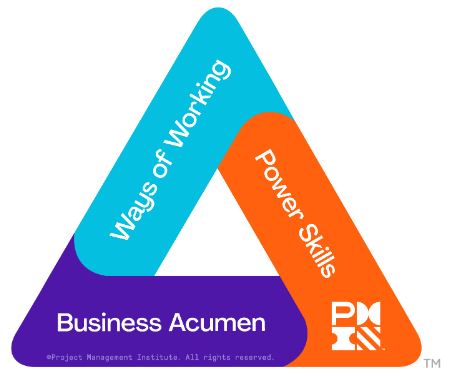
PMI Talent Triangle: Business Acumen (Strategic and Business Management)
Welcome to the PMO Strategies Podcast + Blog, where PMO leaders become IMPACT Drivers!
Today we are going to explore the real reason that we create PMOs and how you might want to think a little bit differently about your PMO and your role as a PMO leader in helping to drive organizational strategy delivery. If you have not listened to episode 000, the Introductory episode, I highly recommend you go back and listen to that episode or read that post first. It sets the stage a little bit for what we’re going to talk about in this here and going forward. It gives you a little bit of a perspective on my background and why I’m so passionate about helping you as a PMO leader achieve the highest possible return on investment for all of your efforts when it comes to building, running, accelerating, or even rescuing your PMO.
Where are we today with PMOs?
That is a big question to understand before we talk about where we want to take PMOs. Recently I was keynoting a conference and also speaking on a panel about PMOs and hosting a PMO workshop. I was sharing the stage with some of my favorite PMO thought leaders on this panel, you will definitely hear more from in upcoming posts and episodes. During the panel, we were asked some very interesting questions about where PMOs are today and where they’re headed. Are we headed for more PMOs? Is the PMO concept dying? Do people really understand what the PMO does? And as we were having these great questions asked, I was really interested in hearing the perspectives of some of my colleagues that were there that literally have decades and decades of experience in the project management space and in PMOs.
I mean we are easily over a hundred years of PMO and project management experience among the people that were on the panel. What was most interesting was thinking about how all of us come from very different perspectives and backgrounds. While our experiences have been different, we all had some really positive things to say about where we believe PMOs are going with the huge caveat that we must make a shift in the way we think about the PMO and the role that the PMO must play in helping to deliver on the strategy for your organization. Okay. Now let’s pause on that for one second. I’m not saying that PMO needs to be strategic, but I do believe that the PMO has a critical role in helping the organization to deliver on strategic objectives. It could be that your PMO has a very functional or tactical place in the organization and you’re just knocking stuff out and getting projects done and that’s great. Alternatively, you could have a seat at the strategy table helping to define the strategy for the organization and anything in between.
What your PMO does from a service perspective is very much dependent on the needs of the organization. That’s why I truly believe that no two PMOs look exactly alike because your PMO should be focused on how you can make an IMPACT and deliver on what the business leaders actually need and are asking for. As we start digging into some of the data and statistics, some of it will sound a little depressing. Don’t worry, I will talk to you about what we can do about what the data is telling us. I can clearly see the gap that I know a lot of PMOs have between what the business leaders want (A.K.A. your sponsor and stakeholders), and what they’re asking for you to help them do (A.K.A. where many PMOs are focusing their energy). Okay, so let’s dig into some of this data and then let’s talk about what we should be doing about it. Now, for some of you, what I share with you is going to be really familiar. Some of the things we talk about, you’re going to say, oh, I resonate with that remark. Others of you are going to say, you know what? I think I’m okay. I am not having this problem and if that’s you I am thrilled. Definitely stick around because I want to feel your virtual head nodding as we go through what we should be doing differently in order to break this trend of PMOs failing to meet business goals.
What is the PMO data telling us?
Let’s start with that. What is it that some of this data was telling me? The bottom line is that far too many PMOs are operating in this kind of average or failing to meet results category. When you look at survey data across industries, so when people were asking at this conference: Are PMOs really the answer to a business leader’s problems or an organization’s problems? It’s a valid question. What does the PMO do for an organization? What is the PMO and answer for and what are they answering? What is the question that we are even asking when we talk about putting a PMO in place and what should the PMO be doing in the first place? When I put together my IMPACT engine PMO training course that helps PMO leaders get from zero or starting from scratch to a high IMPACT PMO in 90 days or use the program to uplevel their PMO, I did a ton of research and I pulled together all the sources that I could find across different categories. The trends were kind of the same, whether it was project management or the PMO.
For example, a Standish Group chaos report said only a third of projects are considered successfully completed on time and on budget. You’ll learn from me over the coming weeks and episodes that I believe there is so much more to defining success than “on time and on budget.” We have to go way beyond the triple constraint and EVM. We have to at least be able to get them on time and on budget. We’ll talk a lot about going beyond “on time and on budget” and really making an IMPACT, and really achieving value well beyond the triple constraint. Come on guys, we got to at least be able to get the triple constraint right first. An IBM change management survey of 1,500 executives said only 40% of projects meet schedule, budget, and quality goals. That’s triple constraint all day long, and it was saying that we aren’t even getting our projects completed according to the goals that we’ve established in the first place. By the way, those that were surveyed, the executives, those are our true stakeholders. Those are the people that we should be talking to about what a successful project looks like. If the executive perspective is we ain’t cutting it, then that’s something we should be paying attention to. I also looked at a Gartner PPM summit survey and it said 68% of stakeholders perceive their PMOs to be bureaucratic.
Now, that’s a pretty big number. And I’m telling you, if people are saying that your PMOs bureaucratic, you aren’t solving business problems. Those who have to engage with you need to feel like the services you’re providing and the value you’re contributing is helping them as an enabler to project throughput, to IMPACT realization, to return on investment. So if they’re saying you’re bureaucratic, then what you’re hearing is you are throwing way too much of the templates, tools, process language at me and not enough of helping me get it done. You’re not delivering where the PMO needs to be delivering. That’s what they’re thinking. And that’s what we’ve got to consider when we look at how the PMO can make an IMPACT in our organization. But hang in there, don’t worry about it if you’ve been called bureaucratic, it’s okay. We will definitely unpack the layers here. In fact, in the next six weeks, we are going to dive into all about helping you to shift your mindset and shift your way of thinking to become a high IMPACT PMO leader. So hang tight, we got your back.
Take a minute to imagine this scenario, or maybe you don’t even really need to imagine the scenario because you’re living this reality every day. Imagine as a PMO leader, you are constantly under stress to do more, to give more, to be more strategic, to get the results, and to make an instant IMPACT. Everything’s got to be done yesterday. You don’t have a lot of time to prove your value and worth and so you find yourself spending your time convincing or begging or trying to help people see how the PMO is going to make an IMPACT. On top of that, you’re not given a whole lot of support or the necessary resources you believe you need to get the job done. That’s the scenario that so many PMO leaders face every single day and a lot of times, the worst part is they’re frustrated and confused. They think they’re doing all the things they’re supposed to be doing because they read a book, or because they went to a course, or because they read something online. They were told this is what a PMO is supposed to do, and so they’re really busy doing that stuff and the business leaders still aren’t happy.
Many of these PMO leaders live in a constant state of not being sure where their funding is gonna come from or if they’re even going to be around next budget cycle. Is their PMO going to be on the chopping block next time? They’re making a decision as to which group gets funded. They’re not even sure. Now, that is a really high-stress environment that keeps PMO leaders in this constant survival mode instead of thriving and growing and evolving to meet business needs. That’s where I want to take you in the upcoming weeks. It’s incredibly frustrating when you believe you’re doing the right things, the things that you were designed to do as a PMO and your business leaders are frustrated. If any of that does sound familiar to you, don’t worry about it. I’ve got your back. We are going to be all over it. If it doesn’t sound familiar to you, thank goodness, I’m glad to hear it. I’m curious about your thoughts on this next statistic.
Forester did a survey and found only 40% of teams reported a positive relationship with the PMO. Only 40%, so that means 60% of teams that have to interact with a PMO see it as a chore, see it as a negative experience because they don’t have a positive relationship or maybe no relationship at all with the PMO. I mean of course, your PMO is not going to be successfully implemented or gain that critical support or the engagement or be seen as a driving force to help an organization delivers strategy if that relationship is not there. Think about it. This applies to every organization and every relationship. If people don’t have that positive relationship with the PMO, then, of course, the statistics are going to be terrible because the PMO must have that positive relationship just to get done. All the things have got to get done in many organizations with very little authority or ability to drive the change they really want to drive. That authority will come and does come once you’ve built the credibility and you’ve solved business problems and that is a huge part of all of this.
The common thread I see running through a lot of these statistics is the PMO was not providing a service that the organization, business leaders, or teams that had to interact with it found valuable. That’s it. It’s that straight forward. Over the coming weeks, we’ll talk about how we need to think differently in the IMPACT PMO leader mindset series. Then we will dig into each one of these challenges, the pain points you might be experiencing, and talk about how you can do things differently to get a quick result of much greater engagement, support relationships and making the IMPACT that your PMO is meant to make. To do this, we’re all going to have to forget a little bit of what we’ve been taught. There is a lot of data out there, a lot of books, a lot of resources, a lot of people online, a lot of courses, and a lot of articles all telling you all of the “shoulds” you should do with your PMO and how important it is to start with tools and process. We’re going to have to break some of our bad habits and unlearn some things that we’ve been told in order to get to that business focus direction that ensures sustainability positioning the PMO to thrive in any organization.
The Good News for PMOs
Now, how about some good news? More good news than the good news that you are not alone if you’ve experienced any of these challenges or the good news that I’m going to help you hand in hand walk through all of the tough scenarios, all of the challenges, and help you solve these problems. Here’s the upside, I saw some really good news when I continued to do my research. A bright star of opportunity as I continue to dig in and say, okay, there’s gotta be some goodness here with the PMOs because my gut tells me, my colleagues are telling me, the industry is begging for a PMO to solve business problems. So where is that data supporting that need? And I found it in a PMI pulse of the profession survey. This survey’s given to organizations all over the world that have PMOs and do project management. And here’s what that data was telling us. This report was explaining that strategically aligned PMOs have a much higher success rate than those with low strategic alignment. Makes Sense, right?
The percentage of projects that are actually meeting goals is significantly higher and the percentage of projects that are deemed as failures is significantly lower when the PMO has a high alignment to organizational strategy. So, what we can see from that data is that PMOs are playing a greater role in driving strategy delivery than they had been previously in prior years when PMI had done this study. And that there is some great opportunity for PMOs to play a role in supporting the organization to make an IMPACT. I don’t remember. I’m not saying that every PMO must be strategic, but you got to have that strategic alignment and I believe you’ve got to have that alignment right from the start with your PMO. If you want your PMO to be a sustainable and IMPACT driven business unit that is seen as an equal with other business units in the organization that are all focused on service and delivery of value for the organization. And that sounds pretty straight forward. Actually we know the answer but still many are struggling to find that way, that path to high IMPACT.
So over the next weeks, we’ll talk through the secrets that will help you personally to make those critical shifts so that any PMO, your PMO, your colleagues, PMO, all the PMOs out there can go from being average to that high IMPACT engine that the business leaders are craving. And it all starts with us and our way that we think about how we can deliver value for the Organization for every project every time. So PMOs must drive a higher focus on outcomes and IMPACTs instead of so much focus on outputs and deliverables. Now I’m not saying there aren’t outputs and deliverables, you’re creating things and doing things, but your goal is going to shift and be much more focused on creating greater throughput across the portfolio projects. And instead of being a cost and control function or focusing all of our energy on showing our value by the number of templates or tools or processes we create, we are going to start looking at how we can start driving a high return on investment Roi for every project every time.
If you do that, you will have no worries about simply surviving in your organization because your business leaders are going to be begging for you to help them solve their problems. Okay, so I know that there are some of you out there, I can almost hear it and you’re saying, “yeah, but…” That “yeah but” monster starts to creep into conversations I have with PMO leaders all the time. They’ll say things like, “yeah, but we’re really busy right now. We have way too much on our plates. We have so many things that are already underway and there’s just no way we have time to take a step back and look at what we’re doing and replan or refocus or redefine our strategy for our organization and our PMO. We’re too busy with all the templates or tools or process that we’re building. We’ve got too much going on.”
Are you busy or productive?
I hear things like we’ve got “all this other stuff to do.” PMO leaders ask, “How are we possibly going to find the time to spend refocusing our services and our energy?” My response is simple, take off that “busy” badge because being busy is not a badge of honor. First and foremost, if you are busy, that doesn’t necessarily mean you are making an IMPACT. Busy does not equal productive. I’ll say it again for the people in the back:
Busy does not equal productive.
If any of those statistics resonated with you, if being considered bureaucratic, or stakeholders perceiving that the PMO doesn’t have value, or business leaders saying that projects aren’t even achieving their triple constraint goals, much less their value goals, or that you don’t have a strong relationship with your sponsor, or your stakeholders or business leaders are just not engaging with the PMO. If any of that sounded familiar, then you have an imperative to take a step back and get out of this survival mode and start looking at ways that you can help your organization actually achieve what they’re looking to achieve. Here’s a hint on what they are looking to achieve: it is getting their projects done with as least amount of friction as possible. Your goal as a PMO leader can be to create a frictionless environment where projects can thrive, where projects are not just driving a bunch of deliverables and outputs, but shifting organizations and shifting results and making change happen and creating an IMPACT. That is the result when we’re focused on the outcomes, not just the outputs.
Hit the PMO Reset Button
Look at how you’re serving your organization and take the time to hit the reset button. I will do that with you first with your own mindsets and ways of thinking over the next six weeks, then we’ll start looking at each and every step in the process of building, running, rescuing, or even just accelerating the performance of your PMO. In these upcoming weeks, I’m going to give you some downloadable checklists and resources that you can use to start applying everything that we talk about in these weeks. So that’s the best news of all. There is a huge spark of hope and future for PMOS. There are people that are implementing PMOs really well and I know that they have figured some of these things out and I want to make sure that every single PMO leader benefits from that knowledge, those wins, and the goodness that is out there with PMOs. I truly believe that there is no profession better positioned to change the world as we know it for the better than project management and the PMO is the engine that can generate that IMPACT inside an organization across the globe and in our communities. I am excited to share with you what I have learned over the last two and a half decades of helping organizations deliver big change and transformational IMPACT, and 15 years inside organizations as a PMO leader in your shoes, dealing with the same challenges and frustrations and opportunities that you have in front of you.
Coming up next…
Here’s a little taste of what to expect in the coming weeks when we go into the IMPACT PMO leader mindsets or what I call the IMPACT Driver Mindsets…We’re going to look at new ways of operating and how you can take advantage of what’s working well in your organization and with your peers, other PMO leaders around the world, and add some new ways of thinking about and delivering value for your organization. There are six steps, six mindset shifts that I think are critical and the first one is called instilling focus to set a really strong foundation for IMPACT.
This focus will include: how you are thinking about the work you do, how you get your team’s focused, and how you get laser-focused on the business perspective. Then we are going to explore a very critical shift that you may have made, but your team’s probably haven’t and that is how we shift from focusing on measuring outputs to measuring outcomes. This is an important shift that we’ll start with ourselves and talk about how we can make that shift in our organizations and our project teams, with our project managers, with everyone involved in the project process and change process. Then we’re going to dive into how you can drive relentless performance on the most important priorities. There’s some things we can talk about with how you can streamline and what you should be doing with all this process and tools and templates that you have in place or have been putting in place because we’ve got to perform relentlessly across all of our PMO services and projects so that we can then be prepared to adapt to thrive.
Instead of staying in this constant PMO survival mode, we’re going to look at how we can shift the way we are thinking and how we can be prepared to evolve as the needs of the organizations shift around us. Then in step five, we are going to explore what I call communicating with the purpose to drive actions and decisions so that we make sure everyone is staying laser-focused on the IMPACT and the outcomes that we’re trying to create. And then finally we wrap up the series with a bunch of great techniques that fall under what I call transforming mindsets. First, we start with transforming our own mindsets as PMO leaders and think differently about everything from change resistance to our role in the organization. I have some new roles for you to consider as a PMO leader and once you do that, you’re then able to transform the mindsets of others as to how the PMO can provide value in the organization and ultimately help finally facilitate an IMPACT driven culture for the organization as a whole.
All right, hopefully, I have interested you in coming along with me as we start to dig into the IMPACT driver mindset series starting with instilling focus. Thank you so much for being here, for spending your time with me and allowing me to serve you to help you make a huge IMPACT with the PMO. Make sure you leave a comment below, let me know what resonated with you. Let me know where you had Aha moments. Let me know what you’d like to learn more about in upcoming posts/episodes. I am here with you and for you to make a huge IMPACT. You can also find us on Facebook at the PMO Strategies Podcast Facebook Group where we are going to dive deep on the topics that we’re covering in these podcasts and have some excellent conversation about people’s experiences as they are learning these new ways of thinking and implementation. Thank you so much for your time today. I am incredibly honored and grateful to be a part of your community and thank you so much for being a part of mine. Have a high IMPACT day!
T hanks for taking the time to check out the podcast!
hanks for taking the time to check out the podcast!
I welcome your feedback and insights!
I’d love to know what you think and if you love it, please leave a rating and review in your favorite podcast player. Please leave a comment below to share your thoughts. See you online!
Warmly,
Laura Barnard







